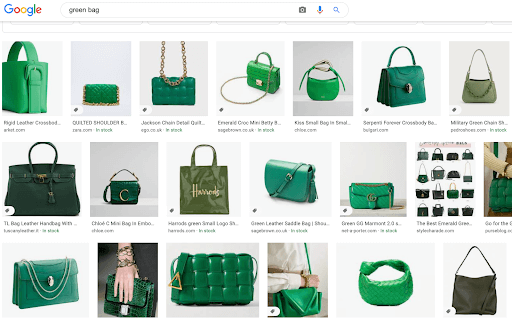SEO Checklist for Luxury Ecommerce in 2022
The beginning of the new year is a fantastic time to take stock of your SEO approach and set the wheels in motion for the coming months. A good start now can see you through the coming year and save you a lot of time and energy in the long run.
The landscape of ecommerce and SEO is constantly in flux, so it’s important to stay updated with changes in the industry and current best practices. Whoever wears your SEO hat can then make sure that your brand is getting the most out of opportunities to be discovered on search the whole year round.
With this in mind we’ve put together a handy SEO checklist for ecommerce businesses in 2022, especially relevant to luxury brands. These 5 detailed tips are actionable ways to improve your SERP (Search Engine Results Page) ranking and see you into the next chapter, as well as prepare you for whatever changes the year will bring.
1. Mark up your structured data
Google announced its most recent best practice guide to structured data in September 2021, aimed at developers. In a recent study by the SEO software agency SEMRush, 50% of the Fortune 500 were not using structured data on their websites. This is a lost opportunity to tell search engines exactly what your content consists of.
In order to deliver optimal results, search engines need to be able to assess the content on your site to decide its relevance and what type of business you have. Structured data helps to contextualise this information, identifying a series of digits as a phone number of a product price. Ultimately this marked-up information might then get displayed on the results page and make your web pages look more appealing.
When used correctly, structured data gets converted into a richer result, known as a rich snippet, on results pages. Without this, or when it is used incorrectly, algorithms are more likely to show a text-only result–which is less engaging and has a lower click-through rate.
For ecommerce sites specifically, it’s possible to add structured data to mark up local business contact information, products, articles, reviews, how tos and a range of other content.

For certain products it’s also common for consumers to use image search. In such cases, structured data can give your products a visual edge. As you can see in the above image search for “green bag”, some companies have marked up products and stock levels using structured data. This affects the layout of the result and makes it look more striking.
Many CMS platforms make it easy to add structured data via a plugin. Talk to your development team to determine the best route. Setting up structured data may require an initial investment, but the visual advantage it affords is usually worth it in the long run.
2. Ensure you have alt text for images
Alt text is often overlooked, especially in contexts where images are often replaced. But in highly competitive environments it might be worth the additional investment of time and effort. Alt text describes the content of images to search engines and to users who are visually impaired.
Ideally, every image on a site should have both a title tag and alt text to go with it in order to be fully optimised. It’s important that this text is also of a high quality, including not only keywords, but describing both what can be seen and what the image does.

For example, the above image is from Gucci’s collaboration with the North Face. Rather than writing just what you literally see in this image: a woman standing in the cold wearing a coat, alt text should also describe what the image tells people: “A model wears a warm winter coat from the Gucci/NorthFace collaboration, shoppable on site.”
Not only do search engines prioritise images that have good quality accompanying alt text when they deliver results, but fully optimised alt text creates a better experience all-round for anyone using your site.
Many situations could cause images not to load properly, there might be a slow connection, a plugin blocking images or the browser might be text only. Good alt text ensures that even in these situations your images are still contributing to the user experience of the page as well.
3. Review your use of keywords
Keywords and SEO go hand-in-hand for good strategy, so this list would be incomplete without a mention of keyword optimisation.
In a report by Mckinsey, 80% of luxury personal sales are influenced by online research, showing just how important it is to make sure you’re connecting with the right audience on search. Increasing visibility relies heavily on using keywords to deliver maximum impact through search results.
The placement of these keywords is just as important as the keywords themselves. These should be included in H1 headings, title tags and URLs for optimal effectiveness and visibility on search.
Do exercise restraint though, it’s quite easy to overdo keyword optimisation. Over-optimised, keyword-stuffed content negatively affects search rankings, and Google is quick to penalise those who forcibly shoe-horn keywords into their content. Being selective over the ones that you choose to use and not being heavy handed in including these in any copy is an important skill set for your copywriting team.
You can easily spot excessive keyword optimisation by looking in the headings, copy and search results entries. If the content is clunky and awkward, it’s likely that optimisation has been applied with too much rigour. It may be time to retrain your copywriting team in the latest best practices.
4. Insist on high quality links
Backlinks continue to be powerful tools for increasing rankings on search, in luxury e-commerce just as much as any other industry.
These should consist of both internal links within your site and external links from other sites in order to generate the most authority for your domain and have a tangible impact on your results page ranking. The emphasis should be on quality, rather than simply quantity.
Search engines are highly effective at assessing the quality of links and use these as a key indicator of quality. In the long term, it’s better to have fewer, quality backlinks that you’ve worked hard to gain, than lots of low quality ones.
For the luxury industry these can be made premium through influencer collaborations that secure a high quality endorsement. A link from the blog of a true collaborator,, as opposed to a site that has low domain ranking and is run by a link-building agency, is worth the additional investment that it requires.
If that investment is beyond the current marketing budget, there may still be opportunities to gain quality links off the back of current marketing activities. Talk to your social team to ensure they’re asking for a corresponding article on any collaborating influencers’ websites (when they have them) and encourage PR teams to always ask for a link.
5. Develop a high quality content strategy
As much as we cringe at the cliché “Content is King”, it is a cliché for a reason, no matter what business you are running. A well-developed and informed content marketing strategy not only improves visibility in organic search, it contributes to sharing your brand story as it evolves over time.
Ensuring that you provide relevant content for your audience, and for discoverability on search, requires an in-depth knowledge of who you are speaking to. 2022 is a year to foster a genuine connection with the people who give power to your brand on a deeper and more personal level, through the content you create.
Long-form video content has proved worth the investment for many luxury brands (look at Gucci, Prada and Chanel). Tesla has a whole section of its “news” folder dedicated just to video. Visual storytelling is the optimal format for holding the attention of the busy consumer, and can be made applicable to a multitude of devices.
A discerning audience wants to be part of the story as it unfolds and to feel that they know the brands they are buying from, while aligning with their goals.
While in the short term this requires a much greater investment, in the long term the return will be a greater connection and investment with your audience and the longevity of their brand loyalty.
Make that investment work even harder by capturing some of the content and transforming it into articles for your blog and other snippets for distribution through your social channels.
2022 looks to be an exciting year that will see plenty of new developments in the world of ecommerce. Utilising these first few months to ensure you approach this with many of the SEO-boxes ticked and your content performing well, means that you are ready to meet change with your best arsenal.




